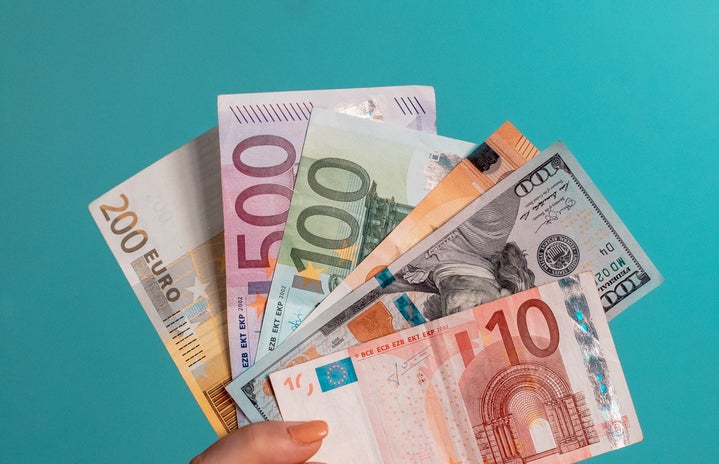Before you start reading this, here’s a quick preamble. If you have a serious and chronic spending addiction, you really shouldn’t be reading my article and should probably consult an actual professional or hire a financial advisor. I don’t have advice-insurance to save me from the possibility of having an angry mob of shoppers come banging at my door because my tips somehow caused them to sink further into debt. But if you have a less severe craving for retail therapy, then carry on and keep reading!
The painful reality of our lives and our economy is that we need to keep spending money we don’t have in order to keep living. We have to pay bills, rent and most importantly, pay for our textbooks. This physical act of spending then starts to become more routine, and for some people, that starts to lead into a completely different spiral filled with miscellaneous purchases that nobody actually needs. So, when the new year rolls in, we make a new year’s resolution to start saving more and spending less. But that usually lasts for two weeks, until we see cute sweaters start to go on sale. And then we might decide to buy a new pair of jeans to go with that sweater because of “I might as well” thinking. And every time we try to quit, some other once-in-a-lifetime opportunity of a sale followed by a measly excuse comes jumping into our lives — you get the idea. It’s a horrible trap. Consumerism damages our worn-out wallets, and suddenly we have more to worry about besides student debt.
Well that’s about to change. Attempting to set a low budget for every month is a great strategy to implement, but if you find yourself frequently going over that amount, then maybe it’s time to try something else first so that you can eventually build up to that level of self-control. I’ve never been a serious shopaholic, but a part of me has always had a soft spot for shopping. However, I’ve recently noticed a huge decline in my miscellaneous spending, and I personally attribute that success to the tips I’ve listed below. Even better, I’ve organized my tips in order from simplest to most drastic, depending on the severity of your love for retail therapy because I’m extra! So, let’s start becoming better versions of ourselves for the new year!
1. Download a money-spending app
I don’t know about you, but my life goes through this specific cycle every time I buy something: I pick something out and go to the cashier, tap my credit card as quickly as I can, then shove my purchase in my bag so that I can pathetically convince myself that I didn’t actually spend any money. It makes it annoyingly easier to purchase things when you’re using a credit or debit card. You literally tap your card for two seconds and somehow in that small timeframe, you’ve lost a hundred dollars. So, one thing I like to do is download a money-spending app that tracks my shopping metrics. A lot of banks have their own version of this app, so your bank probably does as well. Whenever I see that phone notification reminding me that I just spent an obscene amount of money, I die a little on the inside because I’m forced to face the fact that I just wasted money. It’s a rude wake up call, but it really pays off in the long-term.
2. Declutter your surroundings
I really can’t explain the logic behind this tip, I just know that it works for me really well. I once watched a video that explained how the state of clutter in your bedroom subconsciously represents the level of stress you are feeling and your overall state of mind. I thought it was cool but at the same time, I thought it was like those deep things you hear that try to make sense of things but don’t actually seem legit. Now I’m convinced otherwise. I’ve gotten into the habit of making my bed more and bringing less belongings and clothes with me to my university apartment. When my room is clean and there’s less clutter around me, I feel a lot more peaceful and at ease. And when I start feeling that way, I’m less likely to purchase things. I’m not sure why this is the case, but maybe it’s because when I feel more peaceful, I want to start being more productive and then I get too busy with work to actually shop. Anyways, if I ever become textbook-famous for a theory, it’ll be for this: The less clutter you have in your life, the less clutter and spending you’ll want to add into your life.
3. Watch “Confessions of a Shopaholic”
Yes, I know what you’re thinking. If you just read that subheading and immediately thought “this girl is officially crazy and we’re going to start a petition to ban her from giving advice,” I don’t blame you at all. It does sound ridiculous at first. In fact, if you have a serious addiction to shopping, please ignore this tip because this movie does have some…designer triggers. But hear me out first, because things are about to get super deep! While I won’t be a bad person and spoil the movie for you, I can definitely tell you that this movie truly captures how easy it is to spiral out of control, go into massive debt and negatively impact not only yourself, but the people you love. It’s a quirky, brilliant and highly-underrated romcom that showcases the journey that a shopaholic takes into becoming financially independent and her steps in turning her entire life around. This may seem counterintuitive at first, but by the end of the movie, you’ll be itching to start your own journey towards becoming financially-savvy. You’ll also want to learn more about personal finance! Or maybe I’m just a dork, but I’m totally okay with that! My personal opinion? Make sure you watch until the very end, aka the beginning of the credits.
4. Repeat after me: Bulk buying is a trap
Don’t get me wrong. Investing in non-perishable essentials like toilet paper, toothpaste and tampon packs don’t really count as unnecessary bulk-buying. Now the key emphasis here is on the word “essentials.” And no, an extra pair of sparkly stilettos do not fall under the same list. There is never going to be a moment in your glorious life where you suddenly don’t need toilet paper unless technology somehow advances to the point where toilet paper becomes reusable (gross), but the same can’t be said for those shoes. This thinking becomes a problem when you start applying it into other things in your life, such as buying ten cashmere sweaters to last you until you’re fifty years old so that you never have to buy a cashmere sweater again. That’s not investing anymore. That’s an excuse and I’ll tell you what ends up happening. You end up with a wardrobe full of unnecessary clothes, and only end up wearing the same three shirts over and over again. Only bulk-buy when it comes to absolute essentials, otherwise, you’re better off buying what you need only when you need it.
5. Site blocker for your favourite online shops
Okay, so if you’ve reached this stage, then maybe it’s time to start ramping up your strategies. Download a mobile/computer app and a chrome extension for blocking websites. Take one last wistful glance at those online shopping sites before you start adding them onto your blocked list. Better yet, have someone trusted, like a family member, set a password for you so that you can’t cheat and unblock sites (yes, I read your mind and I can see right through you). It’ll be really annoying at first, so try doing this successfully for a few days. Once you get through that, try it again for a week, and so on. Eventually, this will become an easier routine to abide by. We’re so used to checking out what products a store has online when we’re bored or have nothing better to do on our computers, and that act of visiting online sites becomes a habit. Once that becomes a habit, stores have more opportunities to show off their new arrivals and get into our minds. So why don’t we change these habits for the better instead?
6. Last resort: Freeze your credit cards!
I first read about this technique in one of David Chilton’s financial planning books (way to go Laurier alumni!) and thought it was the funniest and most random thing ever. The concept behind this tactic was essentially trying to help people avoid impulsive purchases by (literally) freezing their debit and credit cards. If they wanted to buy something, they’d have to take out their giant block of ice and wait for it to melt in order to get their card and make their purchase. But once the ice melted, their urge to purchase whatever it is they wanted to purchase before would disappear. This is the ultimate anti-retail therapy step and for your own sake, I pray none of you never have to reach this stage. But if you do, I promise there is no judgment here because at least you’re taking action to try and change things. And also, please let me know if it works because I am so curious.
The act of trying to completely change a habit is an extremely difficult thing to do — but there’s no better time than the present. Every step we take is a step forward, no matter how big or small that step is. I hope this year ends up being the year you accomplish everything you’ve ever wanted to accomplish. And I hope you’re able to overcome your shopping habits, no matter what level you are on the shopaholic scale. Who knows, maybe you can ironically reward yourself with a shopping spree after accomplishing your goal of spending less! But let’s not get too carried away, shall we?


